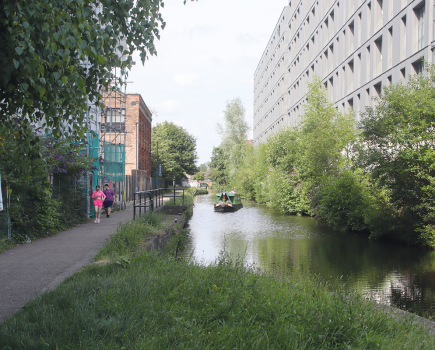Martin Ludgate goes looking for the various devices intended to help with the hard work of accelerating unpowered loaded working boats out of locks – namely, hooks and pulleys!
The Inland Waterways Association is running a campaign to highlight hidden and often overlooked aspects of our waterways heritage – to find out about it, download a heritage spotter’s guide and see a gallery full of lots of photos of hidden heritage from around the waterways network, click here

Look at the top of the coping stones on the offside (non-towpath side) wing walls at the head or tail of many of the locks on the Worcester & Birmingham Canal, and sticking out of the top of one of the stones you may well see a small, curved iron spike. This, to give it its proper name, is a blocking hook – and its function was to help make work easier for boat horses, in the days before powered craft.
As anyone who’s had to bowhaul a boat will appreciate, the hardest part for a horse was getting a fully loaded boat started from the constricted channel of a lock chamber. Once the boat was moving, keeping it going was relatively light work and the horse could keep it up all day. The idea of the blocking hooks was to make the horse’s job easier by providing a two-to-one mechanical advantage, in the same way that pulleys are used to make lifting heavy loads easier – in fact the word ‘blocking’ refers to the (often maritime) use of ‘block’ to mean a pulley.

How did canal hooks and pulleys work?
The way it worked was as follows. When setting off from the lock, instead of the towing line simply being connected directly from the boat’s towing mast to the horse’s harness, it would be attached to the blocking hook (using a loop on the end of the line). From there it would run back to the boat, around a pulley attached to the mast, and forward to the horse. This meant that when the horse set off, it would be walking at approximately twice the speed that the boat was moving at, and would only take about half as much force to get it moving.
As the boat left the lock, and the distance between the mast and the blocking hook shortened, a toggle attached to the rope at the appropriate point would reach the mast, and lodge against the pulley. From this point on, the boat would be being pulled directly by the horse, the length of rope between the pulley and the blocking hook would go slack, and the loop would slip off the hook as the boat passed it.
This was the system used on the Worcester & Birmingham Canal, but other canals used different methods to achieve similar results. On some waterways (including the Coventry Canal at Atherstone), instead of hooks you’ll see pulleys mounted on the locksides or (as on the Stratford at Lapworth) in one case mounted on a split-bridge over the lock tail.
On the slightly larger scale waterways of the London area including the River Lee and Brentford Locks, you’ll see some similar but larger pulleys – in this case used in combination with powered capstans to propel unpowered lighters out of the locks, rather than to help the horses. And some of the Regent’s Canal locks are fitted with multiple pulleys.
Look out on your travels for more examples of these efforts to ‘spare the horses’.
The use of blocking hooks for horse-boating on the Worcester & Birmingham Canal was recreated with two loaded horse-boats in 1997 at an event set up by the then British Waterways, the Boat Museum and the Historic Narrow Boat Club, under the guidance of former working boatman Tom Mayo whose experience went back to horseboating days. It was recorded on video; unfortunately the excerpt available on YouTube omits any footage of the blocking hooks in use! However there’s a description with photographs on Chris Deuchar’s website

Image(s) provided by:
Martin Ludgate








